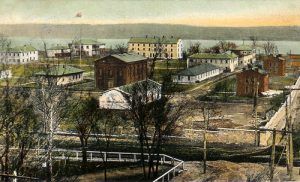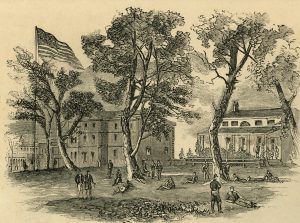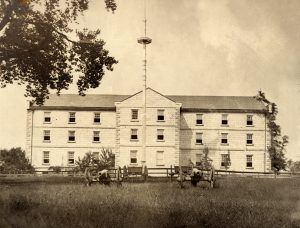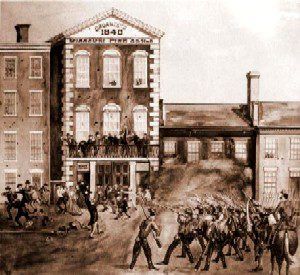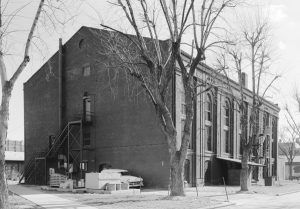The St. Louis, Missouri Arsenal is a large complex of military weapons and ammunition storage buildings owned by the United States. The arsenal, which was built in 1827, is still utilized today. In 1825, the arsenal was located at Fort Belle Fontaine, some 15 miles north of St. Louis, Missouri, but the old fort and its small arsenal were falling into disrepair. Additionally, the War Department felt it needed a more extensive facility and began planning to build a new one.
Lieutenant Martin Thomas selected A new site on a bluff overlooking the Mississippi River. The 37-acre site was advantageous for its strategic view, access to the river, and proximity to the main area military base — Jefferson Barracks. In 1827, the first building on the new arsenal grounds was completed, but it would be a year before storing the ammunition. In the meantime, Fort Belle Fontaine continued to supply ammunition and military supplies to troops operating in the Louisiana Territory until June 1828.
Fort Belle Fontaine was abandoned when the St. Louis Arsenal began storing ammunition and supplies. The new St. Louis Arsenal grew to house a large three-story brick building, an armory, an ammunition plant, and several wagon repair shops. By 1840, 22 separate buildings had been erected, and a garrison of 30 ordnance soldiers manned the site, along with 30 civilian employees, who assembled finished weapons and artillery.
When the Mexican-American War erupted in 1846, the arsenal was busy producing small arms, ammunition, and artillery, increasing its civilian workers to about 500 men. During the war, the arsenal had 19,500 artillery rounds, 8.4 million small arms cartridges, 13.7 million musket balls, 4.7 million rifle balls, 17 field cannons with full attachments, 15,700 stands of small arms, 4,600 edged weapons, and much more. When the war was over, the civilian staff was reduced to about 30, and the arsenal was relatively quiet for about a decade until the Utah War began in 1857. Civilian staff was once again increased, this time to about 100 civilians.
Before the Civil War, several members of Congress anticipated secession. They demanded that their quota of arms and ammunition be shipped from the St. Louis Arsenal to state armories and arsenals. In December 1860, President James Buchanan’s Secretary of War, John B. Floyd, a Virginian, was accused of aiding in transferring arms to southern states. He quickly resigned from his post and returned to Virginia. Afterward, an investigation was conducted into his involvement, where it was found that he had bolstered the Federal arsenals in some Southern states by over 115,000 muskets and rifles in late 1859. He had also ordered heavy artillery to be shipped to the Federal forts in Galveston Harbor, Texas, and Fort Massachusetts in Mississippi. Though he was officially cleared of any wrongdoing, many continued to suspect that his involvement had helped arm the Confederate States of America in preparation for the Civil War.
By early 1861, the Civil War was looming, and the states were choosing sides. Missouri was caught in the middle as most of its residents supported slavery. Despite this, the Missouri Constitutional Convention of March 1861 voted to stay with the Union but refused to supply men or weapons to either side if war broke out. This resulted in a war within its borders between the U.S. Army and Missouri citizens, and the St. Louis Arsenal would become a primary target.
In March 1861, General Nathaniel Lyon arrived in St. Louis to command Company D of the 2nd U.S. Infantry. At that time, Missouri Governor Claiborne F. Jackson was a strong Southern sympathizer, as were many state legislators. Lyon was accurately concerned that Jackson might try to seize the federal arsenal in St. Louis if the state seceded. The Union had insufficient defensive forces to prevent the seizure.
One of Lyon’s first objectives was to strengthen the arsenal defenses, but his superiors, including Brigadier General William S. Harney of the Department of the West, opposed him. However, Lyon soon requested the aid of General Francis P. Blair, who agreed that southern leaders might try to carry neutral Missouri into the Confederate movement. Lyon was soon named commander of the arsenal, and General Blair formed a secret paramilitary group of 1,000 men called the Wide Awakes.
On April 20, 1861, a pro-Confederate mob at Liberty, Missouri, seized the only other arsenal in the state — the Liberty Arsenal. The Southern sympathizers captured about 1000 muskets, four brass field pieces, and a small amount of ammunition. It was the first civilian Civil War hostility against the Federal government in the state.
In response, Lyon armed the Wide Awake units and, on April 29, secretly sent all but 10,000 rifles and muskets to Alton, Illinois. A few days later, on May 10, he directed the Missouri volunteer regiments and the 2nd U.S. Infantry to capture a force of Missouri State Guards stationed at Camp Jackson in the suburbs of St Louis to seize the arsenal. Federal troops surrounded and captured the camp, forcing its surrender. Though Lyon’s actions gave the Union a decisive initial advantage in Missouri, it also inflamed secessionist sentiments.
After capturing the force of Missouri State Guards, Lyon marched them through the streets of St. Louis to the Arsenal. This long march was widely viewed as public humiliation for the state forces and angered citizens who watched the commotion. Before long, riots broke out as Missouri citizens hurled rocks, paving stones, and insults at Lyon’s troops. When a pistol was fired into their ranks, fatally wounding one Union soldier, the Federals fired into the crowd, killing some 20 people, some women, and children, and wounding as many as 50 more. Known as the “St. Louis Massacre,” the incident sparked several days of rioting that was only subdued with the installation of martial law and the arrival of Federal Regulars. The highly-publicized affair further increased the tension in the border state of Missouri.
Later, General Nathaniel Lyon was killed in the Battle of Wilson’s Creek on August 10, 1861. The St. Louis Arsenal remained in Federal hands throughout the Civil War and, with St. Louis firmly in Union control, provided substantial quantities of war materiel to the armies in the Western Theater.
When the Civil War was over, the arsenal again became relatively quiet. In March 1869, ten acres of arsenal grounds were given to the City of St. Louis to create Lyon Park, named for General Nathaniel Lyon. Two years later, in 1871, it was determined that the ammunition could be better secured at Jefferson Barracks, and the supplies were transferred, though the U.S. Army retained the arsenal grounds.
Later, the arsenal complex was transferred to the United States Air Force and the Department of Defense. Today, it is an active military reservation, housing a significant branch of the National Geospatial-Intelligence Agency.
Most of the St. Louis Arsenal and its grounds are closed to the public today. Visitors and cameras are not allowed inside the complex, but you can still visit a part of the arsenal that is open to the public. Nearby is Lyon Park, located near the intersection of South Broadway and Arsenal Streets.
© Kathy Alexander/Legends of America, updated June 2023.
Also See:

